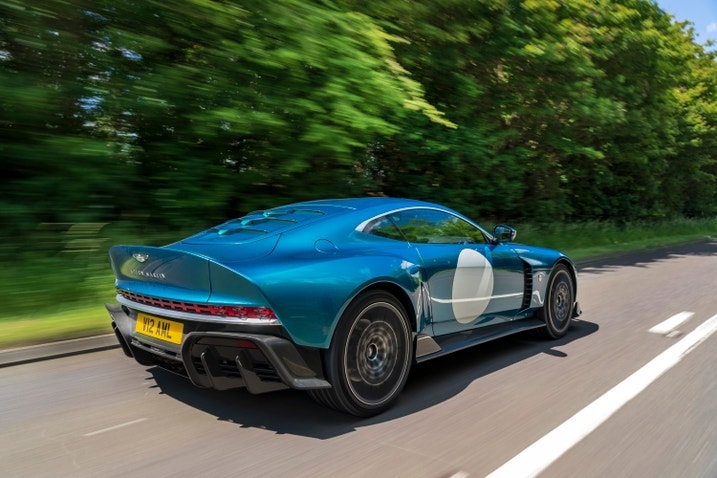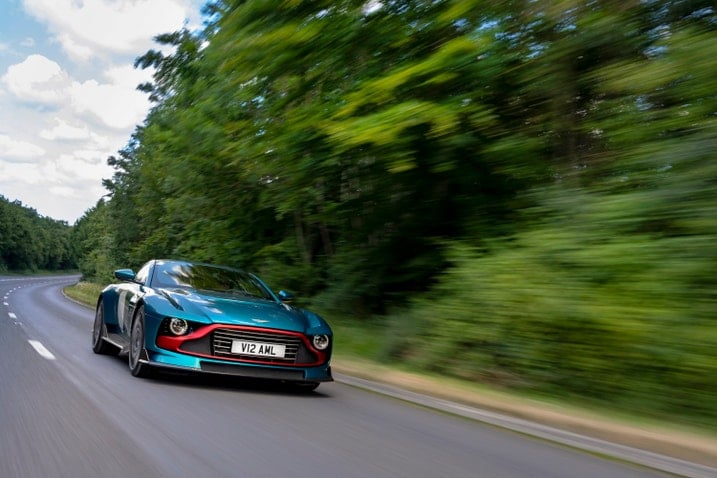- A greatest hits of Aston Martin eras, the Valour blends styles and trim and materials from its 110-year road and racing history.
- 705-horsepower twin-turbo V12 engine is mated to a six-speed manual transmission and drives the rear wheels only.
- Production is limited to just 110 examples globally.
The Aston Martin Valour Is a Fitting Ode to Aston's 110 Years
As celebratory models go, a stick-shifted V12 that looks sensational works for us …
It’s almost a year to the day since Aston Martin revealed details of the Valour, a car it’s built to celebrate 110 years of the company. Only 110 will be produced, and they’re all sold out, so even if you want one, you’re bang out of luck. You might get lucky and secure one of the 38 examples of the Aston Martin Valiant the automaker debuted in the past week, with the Valiant being an even more hardcore track-biased (but still road-legal) version of the Valour. That car’s specification is allegedly based on the requests of Aston Martin’s star F1 driver, Fernando Alonso.
There is another limiting factor beyond the limited production number and a base price that's comfortably north of $1 million before you start personalizing it. Aston Martin’s decision to make its celebratory model with a manual transmission is more than likely to put off a few prospective squillionaire owners more used to their playthings being two pedals and paddle-shifted. If you like your driving old-school, with three pedals and a gearstick, then there are few new alternatives. The only other car coming to mind is the Pagani Utopia, which is offered with a V12 and the option of a manual transmission.
Aston Martin doesn’t give that choice and, apparently, nobody’s asked it for a paddle-shifted one. The specification did raise a few eyebrows among the company’s suppliers, as there aren't many requests for stick shifts these days, and certainly not ones built with the ability to cope with the output from a 5.2-liter twin-turbo V12 engine. We appreciate the approach, because that 'stick really works with the old-school schtick. We’re about to find just how well during a drive on roads not too far away from Aston Martin’s Gaydon HQ in an unseasonably sunny England.
Goodness, it’s a looker …
Before we get down to stepping inside, there's the necessary pause to chat to everyone who’s stopped to gawp slack-jawed at the Valour. Aston Martins always provoke a reaction, and in the quarter century this writer’s been lucky enough to grab the keys for many of them, that response has universally been positive. Today’s no different; the Valour is the subject of nearly every smartphone camera in the vicinity, and a handful of well-informed bystanders ask for the finer details about the beauty before them. The Valour unashamedly harks to the look of the one-off Victor of 2020 — a bespoke One-77 and Vulcan mash-up which itself referenced the unique RHAM/1 race car.
That one-time '70s Le Mans racer gained the nickname "Muncher" due to its propensity to eat brake discs, but there are no such worries with the Valour. It has massive carbon-ceramic rotors front and rear, with the fronts grabbed by six-piston calipers and the rear by four-piston units. Stopping power should prove ample, then, which is no bad thing when under that lengthy carbon-fiber hood lies the twin-turbo V12 with 705 horsepower and 555 lb-ft of torque.
Aston describes the overall look of the as Retro Futurism, a mix of the old and new, and it's an apt description. Aston’s director of design, Miles Nurnberger, elaborates, explaining that the idea of the Valour’s look was to have touchpoints on the car that gave the impression that the car’s been modified over time in the pursuit of greater speed. The front grille and box vent behind the front wheels are examples of this, as is the panel where a rear window would usually be.
More reverential nods inside
Escaping the Aston inquisition and slipping into the interior reveals more of the reverential, historical referencing. The lightweight carbon-fiber-shelled seats are covered in a woolen tweed that serves as a nod to Aston Martin’s 1959 Le Mans-winning DBR1. The tweed is complemented by leather, brushed metals, carbon fiber and even wood — if you want it — trim. The shift lever is topped with walnut. Naturally, any element inside can be modified its owner's wishes (we’d cover all the carbon fiber with leather if it were ours). It’s a finely curated look that’s technical but fairly simple, much like the somewhat ancient Mercedes-Benz-derived controller that operates the infotainment system. It works, and in truth a touchscreen would be out of place here.
If there’s an element inside that grates, it’s the digital instrument panel. This, the most analog of Aston Martin, is crying out for someone to have dusted off proper physical instruments from the company’s parts back catalog. The rearview mirror is similarly incongruous. It displays a camera-sourced image due to there being no rear window behind the driver and passenger, but the image is distracting enough that we reached for an off button.
Behind the wheel
Push the clutch and brake pedals, and press the ignition button, and the V12 fires with a quick flare before setting into a cultured, smooth idle. The clutch is surprisingly light, and deliberately so, as this is an area that Aston has spent a great deal of time perfecting. The bite is easily felt, with the engine’s calibration such that it doesn’t burden the driveline with too much, too soon. All that makes it a cinch to pull away in — which is perhaps no bad thing given the near 100% possibility you’ll have an audience when doing so.
Once moving, the gearshift proves similarly accurate and light, the process effortless, to the point where it actually feels a little bit too easy. The lack of physicality is somewhat at odds with the expectation and anticipation of a thumping V12 mated to a manual transmission. If there’s a hint of imperfection, it’s the heat soak coming through the exposed linkage. It's enough for us to ponder whether the vents fore of the gearstick are fixed in position to draw some of the heat away from it. Part of the civility is the nature of the engine. The Valour is quick — anything with 705 hp will be — but it lacks the low-rev urgency and whipcrack pace you might anticipate. The transmission is also geared long enough that you don’t need to be too busy with the stick.
Should you shift with urgency, the pedal spacing and weighting are such that it’s perfect for rev-matched heel-and-toe downshifts, which you’ll need to do, as there’s no automatic throttle blipping. On the subject of pedals, the throttle travel seems rather short, meaning you’re often pushing it to its stop, which perhaps exacerbates that sometimes lack of acceleration response.
There are some rousing sounds from the exhaust. The lightweight bespoke system is 1 mm thick and crackles, pops and bangs like a campfire with a box of fireworks dumped on it when you lift off in the Track driving mode. As you might think, this mode heightens the thresholds of the stability and traction control. Really though, you’ll have to drive it in a most inconsiderate manner for it to misbehave on the road, such are the traction and grip on offer. It steers with uncorrupted precision and even rides decently — which is quite an achievement on the appalling surfaces that pass as roads in the UK — and usefully, given the possibility of having one hand off the wheel to take care of those gearshifts.
Any rivals?
Manual cars are increasingly rare, which is why we applaud Aston Martin’s decision with the Valour, but it does pretty much put it in a class of one. Aston Martin hasn’t revealed any performance figures for it, but we’d suggest a 0-62 mph time of under 4.0 seconds and a top speed close to, if not just creeping past, 200 mph. These are supercar, rather than hypercar, figures these days. That's not really a complaint, though, because it doesn’t need to be faster. We’d be lying if we didn’t want it to be a bit edgier, a bit recalcitrant, busy and more physical even. After all, it is a manual and for that we expected a bit more labor. That said, with its big trunk, comfortable interior and easy nature, it’s a very compelling super GT, for those who like the simple pleasures in life.
Edmunds says
Our thoughts are moot because every Valour is sold, but it’s still one of the first cars we’d buy if we came into a sizable pile of money. That manual is very appealing; it adds so much, and — combined with the knee-weakening looks, gorgeous interior and, surprisingly, usability — has us really wanting one. That said, on reading the Valiant's more track-biased specification, it’s likely we’d want that even more. It sounds like it’ll be harder work, and with a manual, that’s kind of the point.








 by
by  edited by
edited by